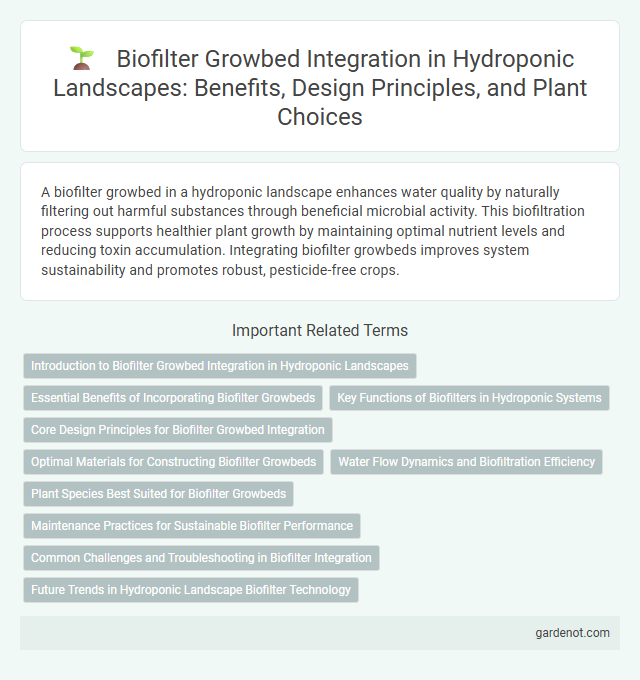A biofilter growbed in a hydroponic landscape enhances water quality by naturally filtering out harmful substances through beneficial microbial activity. This biofiltration process supports healthier plant growth by maintaining optimal nutrient levels and reducing toxin accumulation. Integrating biofilter growbeds improves system sustainability and promotes robust, pesticide-free crops.
Introduction to Biofilter Growbed Integration in Hydroponic Landscapes
Biofilter growbeds play a critical role in enhancing water quality and nutrient cycling within hydroponic landscapes by utilizing microbial communities to break down organic waste. Integrating biofilter growbeds improves system sustainability by promoting natural filtration and reducing the need for chemical treatments. These growbeds support plant health and growth by maintaining balanced nutrient levels and fostering beneficial microbial activity.
Essential Benefits of Incorporating Biofilter Growbeds
Biofilter growbeds enhance hydroponic landscapes by efficiently removing harmful ammonia and nitrate through natural bacterial processes, promoting healthier plant growth. Their ability to maintain high water quality reduces the need for frequent water changes and minimizes disease risks. Incorporating biofilter growbeds supports sustainable nutrient recycling, optimizing resource use and improving overall system stability.
Key Functions of Biofilters in Hydroponic Systems
Biofilter growbeds in hydroponic systems play a crucial role in nitrification by converting toxic ammonia into nitrate, which is essential for plant nutrition. They enhance water quality by removing harmful pathogens and organic waste through microbial activity, promoting a balanced ecosystem. Efficient biofiltration supports sustained plant growth and improved yield by maintaining optimal nutrient cycling and oxygen levels in the nutrient solution.
Core Design Principles for Biofilter Growbed Integration
Biofilter growbed integration centers on optimizing microbial activity through careful selection of inert media with high porosity, ensuring effective water flow and oxygen diffusion to support nutrient cycling in hydroponic landscapes. Maintaining balanced hydraulic retention time is crucial for maximizing pollutant removal and minimizing anaerobic zones that can disrupt biological filtration. Incorporating modular design facilitates scalability and ease of maintenance, enhancing overall system resilience and efficiency in biofiltration performance.
Optimal Materials for Constructing Biofilter Growbeds
Optimal materials for constructing biofilter growbeds include inert substrates such as expanded clay pellets, lava rock, and pumice, which provide excellent water retention and oxygen flow while supporting beneficial microbial growth. These porous, lightweight materials enhance nutrient filtration and prevent root rot by maintaining aerobic conditions essential for biofiltration efficiency. Durable plastics with UV resistance can be used for structural components to ensure longevity and minimal chemical leaching in hydroponic systems.
Water Flow Dynamics and Biofiltration Efficiency
Biofilter growbeds enhance hydroponic landscapes by optimizing water flow dynamics, ensuring even distribution and preventing stagnation that promotes harmful anaerobic conditions. The design facilitates efficient biofiltration by maximizing surface area for microbial colonies, which effectively convert harmful ammonia into less toxic nitrates, boosting nutrient availability. This balance of water movement and microbial activity significantly improves plant health and system sustainability in hydroponic cultivation.
Plant Species Best Suited for Biofilter Growbeds
Biofilter growbeds in hydroponic landscapes optimize water purification and nutrient cycling, providing an ideal environment for plant species with high nutrient uptake and root aeration, such as watercress (Nasturtium officinale), lettuce (Lactuca sativa), and mint (Mentha spp.). These plants excel in biofilter growbeds due to their rapid growth rates and ability to tolerate fluctuating water conditions, enhancing the system's filtration efficiency. Incorporating species like basil (Ocimum basilicum) and spinach (Spinacia oleracea) further improves biofiltration by promoting microbial activity and nutrient absorption in the substrate.
Maintenance Practices for Sustainable Biofilter Performance
Regular cleaning and periodic replacement of biofilter media are essential for maintaining efficient microbial activity and water quality in hydroponic landscape systems. Monitoring pH levels, nutrient concentrations, and dissolved oxygen ensures optimal conditions for biofilter performance and prevents clogging or toxic buildup. Implementing routine inspections coupled with preventive maintenance practices extends the lifespan of biofilter growbeds and supports sustainable, eco-friendly hydroponic cultivation.
Common Challenges and Troubleshooting in Biofilter Integration
Biofilter growbeds in hydroponic landscapes often encounter challenges such as clogging from biofilm buildup, inconsistent flow rates, and nutrient imbalances caused by microbial activity. Monitoring parameters like pH, dissolved oxygen, and nutrient concentration is essential to prevent anaerobic conditions that reduce biofilter efficiency. Regular maintenance strategies include mechanical cleaning, adjusting hydraulic loading rates, and balancing nutrient inputs to optimize microbial processes and system performance.
Future Trends in Hydroponic Landscape Biofilter Technology
Advancements in biofilter growbed technology are driving the future of hydroponic landscapes by enhancing nutrient cycling and water purification efficiency through integrated microbial communities. Emerging trends include the adoption of smart sensors and AI-driven monitoring systems that optimize microbial activity and promote sustainable plant growth. Innovations in biodegradable materials for biofilter substrates aim to reduce environmental impact while maintaining high filtration performance in urban agriculture settings.
Biofilter growbed Infographic

 gardenot.com
gardenot.com